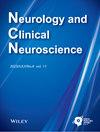A case of catalepsy after multiple cerebral infarctions
IF 0.4
Q4 CLINICAL NEUROLOGY
引用次数: 0
Abstract
Reports of stroke‐related catalepsy and other catatonia syndromes are rare. A 68‐year‐old man was admitted to a local hospital 10 days prior for heart failure. He subsequently developed multiple cerebral infarctions and was referred to our hospital for emergency care. He spontaneously opened his eyes but did not speak. He had hemiparesis on the right side. Diffusion‐weighted imaging revealed high‐intensity areas in the left frontal and parietal lobes and right cerebellar hemisphere. Rehabilitation therapy was initiated in the acute stage. When he was instructed to raise his left upper limb 90°, he maintained the posture for more than 5 min. We hypothesized that catatonia syndromes, including catalepsy, were caused by damage to the orbitofrontal, premotor, supplementary motor cortices, and basal forebrain. These abnormalities disappeared after 4 months. Catalepsy may also be observed in organic central nervous system diseases, such as stroke, and should be considered in stroke care.多发脑梗死后猝倒1例
卒中相关的猝倒和其他紧张症综合征的报道是罕见的。一名68岁男子10天前因心力衰竭住进当地医院。他随后出现多发性脑梗死,并被转介到我院接受急诊治疗。他不由自主地睁开眼睛,但没有说话。他有右侧偏瘫。弥散加权成像显示左侧额叶、顶叶和右侧小脑半球有高强度区域。急性期开始康复治疗。当他被指示将左上肢抬起90°时,他保持姿势超过5分钟。我们假设紧张症综合征,包括猝死,是由眶额、前运动、辅助运动皮层和基底前脑损伤引起的。这些异常在4个月后消失。在器质性中枢神经系统疾病(如中风)中也可观察到猝倒,在中风护理中应予以考虑。
本文章由计算机程序翻译,如有差异,请以英文原文为准。
求助全文
约1分钟内获得全文
求助全文

 求助内容:
求助内容: 应助结果提醒方式:
应助结果提醒方式:


